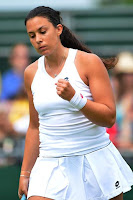There is such a thing as
summer; I’m not making it up. I mean real summer and not the hot, wet, still,
cloudy, grumpy-thunder kind that we’ve been having in the northeast this June and July.
I finally found it at 6:57 a.m. July 12. I woke up in our friend’s house, looked up through the
skylight, which might be a little annoying to some at 6:57 a.m. on another
morning, but not to me on this morning.
I saw a blue sky. If you say,
“big deal,” you obviously haven’t been spending time around New York City
recently. The blue wasn’t just peeking through gray clouds, and it wasn’t
surrounded by haze from high humidity; it filled the frame. I
could feel the fresh air coming in through the open skylight and this thing
called an open window; open is what some people do with a window, when their air
conditioning isn’t running on high 24/7. Amazing, but true.
This was really fresh air with a taste of the sea on it to boot, which
makes sense, since we were on an island, Down East, as they say.
The day before my discovery, on our journey
here, and I’m not making this up either, the temperature gauge on our Volvo C30
dashboard did not make it to 80’F, not even in the first hour it took to drive from
Exit 3 on US95 to Exit 5, which usually takes about four minutes.
An early morning thunder
storm (gee, what a surprise) and heavy rain must have softened a slope of earth
near Riverside CT, because a tree fell from it onto US95, hit the cab of a
passing truck during rush hour and closed two lanes. So, our first four minutes
of the journey took an hour and we had to reset our journey clock and then we drove and
drove north and east and north again then down east. Luckily, there were no
kids in the back to ask, “Are we there yet?” We drove and talked about all the stuff we don't talk about at home for eight more hours. I have a feeling that both the high divorce rate and most long marriages may be directly related to long motor journeys.
We stopped in Yarmouth ME and I dove into a plate-sized harbor full of fried clams on a white flour roll
with tarter sauce and waves of vinegar upon it and drank a lemonade that had sugar in it.
You know what? I survived. Don’t tell Bloomberg; he won’t believe it.
On the mail-boat to Little
Cranberry Island that we caught in Northeast Harbor, a woman put on a Breton striped
sweater. I hadn’t seen a sweater on anyone outdoors in weeks, although I
have seen them on people indoors, freezing from arctic air conditioning. It may have been a cotton sweater, but still.
I can see the island’s harbor
now from where I’m sitting on the porch and can see Mount Desert Island beyond
it. The air is stunningly clear and clean. It’s midday, the sun is shining
brightly amid whisps of clouds and it is unmistakably summer here. Real summer. Tomorrow's forecast promises the same.
A man just rode by on a
bicycle and he wore an outer shirt over a T-shirt and he was not too hot and he
wasn’t racing to beat any thunder and lightning and he did not get drenched, and
by all outward appearances he was thoroughly enjoying himself, outside, in
summer, in the middle of the day.
I saw it right here.
Islesford, Little Cranberry Island, Maine. I swear.





